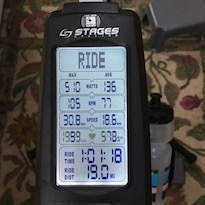Many instructors still teach on the old-school stationary bikes with no consoles, and therefore, no data. Over time, that will change. I am lucky enough to be able to only teach classes on bikes with power meters. Once you start teaching and riding with power, it’s hard to go back. My weapons of choice are the IC7 (by the Indoor Cycling Group) and the SC3 (by Stages).
One of my weekly classes on the SC3 is at a gym that also offers the Les Mills RPM cycle program, both live and virtual. These Les Mills classes do not use the power meters—in fact, they don’t use any feature of the console. Over the last year, another instructor and I who teach freestyle classes, not Les Mills RPM, have worked tirelessly to introduce the use of power to the participants of our classes. The word has spread and every week we get at least one or two new faces. They may be Les Mills RPM veterans and have been using the same bikes that we are, but they’ve never actually used the console on the bike before. It’s been an eye-opening experience.
Not long ago, I had a lovely lady named Mary come into my class on the recommendation of her friend who rides with me every single week since we started teaching with power. She is in her mid-50s and used to be an avid RPM fan. The class she came to was a part of our 6-week FTP preparation program that we have been offering. The class profile that day was 3 x 10-minute intervals. The first set was at 80%–90% FTP, the second set was 100%–105%, and the final set was back to 80%–90%.
My first thought when she came in was, “Wow, this will be a baptism by fire; she may never be back!” But at the same time, I knew this kind of profile is really good for someone new to working with power because spending that long in each zone allows you to connect with your body. We focus on RPE to make sure their breathing and the sensations in the legs and lungs matches what the duration and intensity require. It’s the perfect class for aligning these perceived exertion sensations with their actual power output. Riders have plenty of time to look at the metrics on the console without feeling rushed.
This profile is also ridden in the saddle—unless they require a standing break, participants are seated for the working portion of the 30 minutes. They are free stand in the recoveries, of course. This is especially challenging for someone who is new to this type of class.
I must say that this lady’s determination and focus were second to none. She was thrilled with her results and came up to talk to me after the class. The first thing she said was that she has never worked so much in the saddle. She wasn’t upset or bored like some instructors might think new riders would be—she was surprised. But the real lightbulb moment for her was watching the console every time she sat up for a drink or a rest. She remarked, “It still felt like I was working just as hard, but I could see that the numbers plummeted!”
Another important thing she noticed was the trick your body plays on you when you come out of the saddle. She said, “I am used to RPM and we stay out of the saddle a lot and it feels really hard…so I am shocked to see the reduction in my power output when I stand up.” She discovered the myth that standing for long periods means you are working harder. Sure, you can put out more power in the short term when standing, but most cannot maintain it so power falls.
As an instructor, nothing makes me happier than when my riders take responsibility for their own workout and pay attention to the data—not because I ask them to, but because they want their workout to be safe and effective and they want to see the proof of that. The beauty of teaching with power is that it offers this very proof that other classes without metrics simply cannot match.
Suffice it to say, Mary has been in my classes every week since then and she absolutely smashed her 20-minute FTP test. She hasn’t given up RPM as she has been doing it for years and still loves it, but she comes to my power-based class to challenge herself.
I’m adding Mary to my list of success stories. I hope you have a similar list!


Hi, I have just read this article and also the one on why your classes are so full (love the 15 tips) and I couldn’t agree with you more. I have recently qualified and have delivered a small number of classes and my sessions are based on how I would ride out on the road with the added benefit of music. Once I have explained how I instruct and the reasons why, the riders then have a fun hard session with music they know but most importantly they have a workout that is safe and effective without any of the nonsense that seems to be in vogue at the moment. I am determined to stay true to my style and will let you know how I get on.
Looking forward to my first success story now!
Thank you so much and we are looking forward to your story 🙂
Thank you for sharing this…I’ve been teaching with more and more about power in my classes, and I am also getting good feedback. I love Mary’s success story.
You’re welcome. I am glad your riders see the benefit of riding wit power, too.